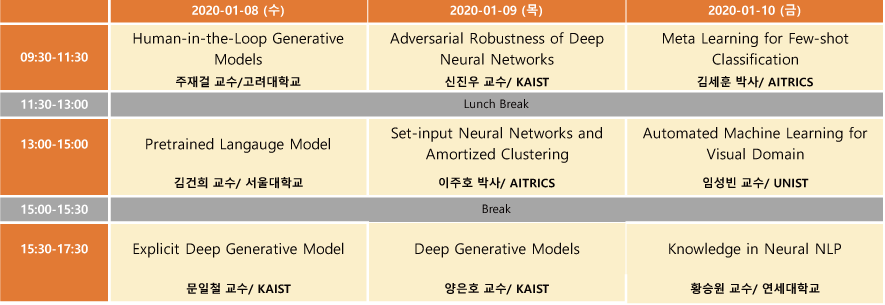2020 인공지능학회 동계강좌를 신청하여 2020.1.8 ~ 1.10 3일 동안 다녀왔다. 총 9분의 연사가 나오셨는데, 프로그램 일정은 다음과 같다.

전체를 묶어서 하나의 포스트로 작성하려고 했는데, 주제마다 내용이 꽤 될거 같아, 한 강좌씩 시리즈로 묶어서 작성하게 되었다. 첫 번째 포스트에서는 고려대학교 주재걸 교수님의 “Human in the loop” 강연 내용을 다룬다.
- Recognition(인지) vs Generation (생성)
- Recognition : compresses a large number of input values into a small number of output values.
- Generation : expands a small number of input values into a large number of output values.
- Translation : transforms a large number of input information into another large number of output values.
- Conditional Generation : An additional input is given, which steers the generation processes in a user-driven manner.
- Applications of Generative Models
- Realistic samples for artwork, super-resolution, colorization, In-Painting, etc
- GANs
- Terminology
- Generative : It is a model for generation
- Adversarial : Improves the generation quality via adversarial training
- Networks : The model is formed as neural networks.
- Current Status of GAN :
- PGGAN : Karras et al. Progressive Growing of GANs for Improved Quality, Stability, and Variation, ICLR’18
- StyleGAN : Karras et al. A Style-Based Generator Architecture for Generative Adversarial Networks, CVPR’ 19
- Several type of GANs
- DCGAN : No pooling layer (Instead strided convolution), Use batch normalization, Adam optimizer (lr=0.0002, beta1=0.5, beta2=0.999)
- pix2pix : Paired Image-to-Image Translation
- CycleGAN : Unpaired Image-to-Image Translation
- CGAN (Conditional GAN) : Mirza & Osindero, Conditional Generative Adversarial Nets, 2014
- ACGAN (Auxiliary Classifier) : Odena et al, Conditional Image Synthesis With Auxiliary Classifier GANs, 2016
- Improves the training of GANs using class labels
- STARGAN : Choi et al, StarGAN: Unified Generative Adversarial Networks for Multi-Domain Image-to-Image Translation, CVPR 2018
- Multi-Domain Image-to-Image translation
- Terminology
- Motivations for Human-in-the-Loop Approach
- User intent are often too complex to describe as a simple categorical variable.
- Flexible, sophisticated forms of user inputs are necessary
- Some among them may not be satisfactory to users nor aligned with user intent.
- Users should be able to partially edit the output in an interactive manner
- User intent are often too complex to describe as a simple categorical variable.
- User Inputs in Generative Models
- Global (male of female) vs. Local (strokes and scribbles)
- Reference-based vs. non-reference-based
- Strokes and scribbles
- Positive vs. Negative clicks (segmentation)
- Particular colors (colorization)
- https://paintschainer.preferred.tech/index_en.html
- Reference image
- User’s own vs. one among a pre-given set
- Concatenation-based
- STARGAN : Choi et al, StarGAN: Unified Generative Adversarial Networks for Multi-Domain Image-to-Image Translation, CVPR 2018
- DRIT : Lee et al, Diverse Image-to-Image Translation via Disentangled Representations, ECCV 2018
- Normalization-based
- MUNIT : Huang et al, Multimodal Unsupervised Image-to-Image Translation, ECCV 2018
- GDWCT : Cho et al, Image-to-Image Translation via Group-wise Deep Whitening-and-Coloring Transformation, CVPR 2019
- SPADE : Park et al, Semantic Image Synthesis with Spatially-Adaptive Normalization, CVPR 2019
- GauGAN : Interactive Tool of SPADE, http://nvidia-research-mingyuliu.com/gaugan/
- GANPaint
- A user edits a generated image or a photograph with high-level concepts rather than pixel colors
- https://www.youtube.com/watch?v=yVCgUYe4JTM&feature=youtu.be
- Bau et al, GAN Dissection: Visualizing and Understanding Generative Adversarial Networks, ICLR 2019
- http://gandissect.res.ibm.com/ganpaint.html
- https://github.com/CSAILVision/gandissect
- Human-machine interaction is almost real-time
- Semantic Photo Manipulation
- Bau et al, Semantic Photo Manipulation with a Generative Image Prior, SIGGRAPH 2019
- https://www.youtube.com/watch?v=q1K4QWrbCRM&feature=youtu.be
- Interactive Colorization
- Zhang et al, Real-Time User-Guided Image Colorization with Learned Deep Priors, SIGGRAPH 2017
- Support both local and global hints
- Global hints can incorporate a particular characteristic of color histogram of a given reference image
- Concatenation-based conditioning
- Sangkloy et al, Scribbler: Controlling Deep Image Synthesis with Sketch and Color, CVPR 2017
- Interactive Colorization via Sketch and Color Strokes
- Simulating User’s Sketch Inputs
- Zhang et al, Deep Exemplar-based Video Colorization, CVPR 2019
- Sun et al, Adversarial Colorization Of Icons Based On Structure And Color Conditions, ACM MM 2019
- Lee et al, Reference-Based Sketch Image Colorization using Augmented Self Exemplar and Dense Semantic Correspondence, under review
- Bahng et al, Coloring with Words: Guiding Image Colorization Through Text-based Palette Generation, ECCV 2018
- Zhang et al, Real-Time User-Guided Image Colorization with Learned Deep Priors, SIGGRAPH 2017
- Interactive Segmentation
- Acuna et al, Efficient Interactive Annotation of Segmentation Datasets with Polygon-RNN++, CVPR 2018
- Ling et al, Fast Interactive Object Annotation with Curve-GCN, CVPR 2019
- Wang et al, Object Instance Annotation with Deep Extreme Level Set Evolution, CVPR 2019
- Future Research Directions
- Support for real-time, multiple iterative interactions
- Reflecting higher-order user intent in multiple sequential interactions
- Revealing inner-workings and interaction handle
- explicitly using attention module
- Better simulating user inputs in the training stage
- Incorporating data visualization and advanced user interfaces
- Leveraging hard rule-based approaches
- Incorporating users’ implicit feedback and online learning
- Useful Links
- 2019 ICML Workshop on Human in the Loop Learning (HILL)
- 2020 IUI Workshop on Human-AI Co-Creation with Generative Models
- Key researchers
- David Bau : https://people.csail.mit.edu/davidbau/home/
- Sanja Fidler : https://www.cs.utoronto.ca/~fidler/
- Richard Zhang : https://richzhang.github.io/
- Jun-Yan Zhu : https://people.csail.mit.edu/junyanz/
- Support for real-time, multiple iterative interactions